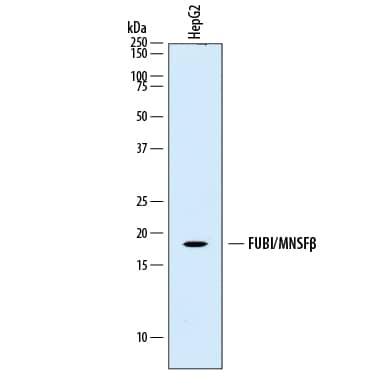FUBI/MNSF beta Products
The Ubiquitin-like Protein Finkel-Biskis-Reilly Murine Sarcoma Virus (FUBI), also known as Monoclonal Nonspecific Suppressor Factor beta (MNSF beta), is a 74 amino acid (aa) Ubiquitin-like protein modifier with a predicted molecular weight of 8 kDa that is encoded by the FAU gene. FUBI/MNSF beta is translated as a fusion protein with the ribosomal protein S30; the fusion protein is post-translationally cleaved into two functional proteins. The mouse and rat FUBI/MNSF beta-ribosomal protein S30 fusion orthologs share 97% and 98% aa sequence identity with the human protein, respectively. Like many Ubiquitin-like proteins, FUBI/MNSF beta contains a C-terminal Gly-Gly motif and can be covalently conjugated to acceptor proteins to form adducts that modulate protein action. For example, FUBI/MNSF beta conjugation to Bcl-G inhibits the ERK1/ERK2 cascade downstream of TLR4 activation in macrophage cell lines. Additionally, FUBI/MNSF beta conjugation to Endophilin II has been shown to regulate Dectin-1-mediated phagocytosis and inflammation. The role of FUBI/MNSF beta downstream of TLR2 signaling is unclear, however novel FUBI/MNSF beta adducts may contribute to TLR2 signaling, as silencing of FUBI/ MNSF beta enhanced signaling via a TLR2-specific ligand.
3 results for "FUBI/MNSF beta" in Products
3 results for "FUBI/MNSF beta" in Products
FUBI/MNSF beta Products
The Ubiquitin-like Protein Finkel-Biskis-Reilly Murine Sarcoma Virus (FUBI), also known as Monoclonal Nonspecific Suppressor Factor beta (MNSF beta), is a 74 amino acid (aa) Ubiquitin-like protein modifier with a predicted molecular weight of 8 kDa that is encoded by the FAU gene. FUBI/MNSF beta is translated as a fusion protein with the ribosomal protein S30; the fusion protein is post-translationally cleaved into two functional proteins. The mouse and rat FUBI/MNSF beta-ribosomal protein S30 fusion orthologs share 97% and 98% aa sequence identity with the human protein, respectively. Like many Ubiquitin-like proteins, FUBI/MNSF beta contains a C-terminal Gly-Gly motif and can be covalently conjugated to acceptor proteins to form adducts that modulate protein action. For example, FUBI/MNSF beta conjugation to Bcl-G inhibits the ERK1/ERK2 cascade downstream of TLR4 activation in macrophage cell lines. Additionally, FUBI/MNSF beta conjugation to Endophilin II has been shown to regulate Dectin-1-mediated phagocytosis and inflammation. The role of FUBI/MNSF beta downstream of TLR2 signaling is unclear, however novel FUBI/MNSF beta adducts may contribute to TLR2 signaling, as silencing of FUBI/ MNSF beta enhanced signaling via a TLR2-specific ligand.
| Reactivity: | Human |
| Details: | Rat IgG2b Monoclonal Clone #861504 |
| Applications: | WB, ICC |
| Reactivity: | Human, Squirrel |
| Details: | Mouse IgG2a Kappa Monoclonal Clone #3C10 |
| Applications: | WB, ELISA, ICC/IF |
| Reactivity: | Human |
| Details: | Rabbit IgG Polyclonal |
| Applications: | WB |



![Western Blot: FUBI/MNSF beta/FAU Antibody (3C10) [H00002197-M03] Western Blot: FUBI/MNSF beta/FAU Antibody (3C10) [H00002197-M03]](https://resources.bio-techne.com/images/products/FUBI-MNSF-beta-FAU-Antibody-3C10-Western-Blot-H00002197-M03-img0002.jpg)
![Western Blot: FUBI/MNSF beta/FAU Antibody [H00002197-D01P] Western Blot: FUBI/MNSF beta/FAU Antibody [H00002197-D01P]](https://resources.bio-techne.com/images/products/FUBI-MNSF-beta-FAU-Antibody-Western-Blot-H00002197-D01P-img0002.jpg)